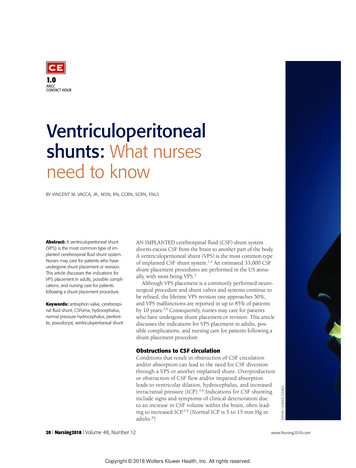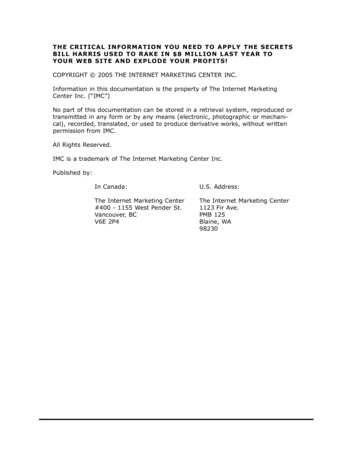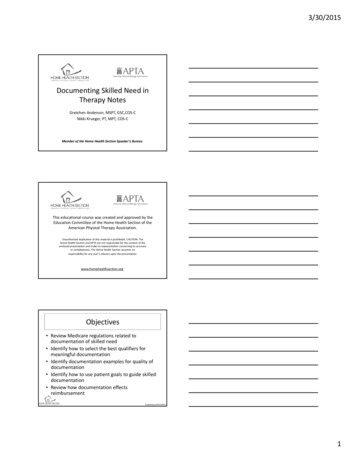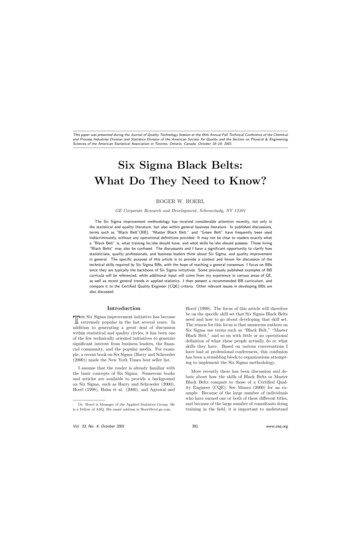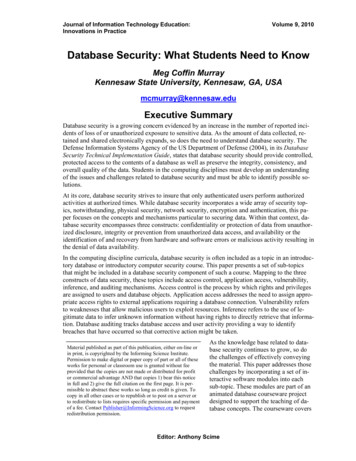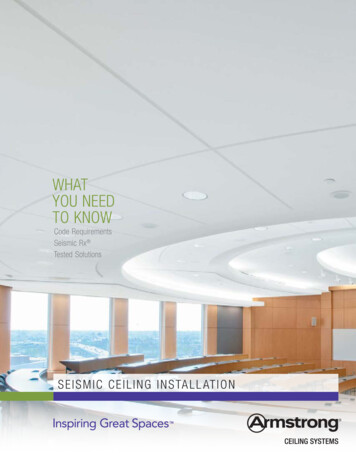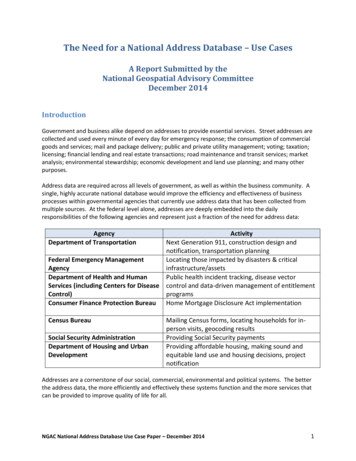
Transcription
The Need for a National Address Database – Use CasesA Report Submitted by theNational Geospatial Advisory CommitteeDecember 2014IntroductionGovernment and business alike depend on addresses to provide essential services. Street addresses arecollected and used every minute of every day for emergency response; the consumption of commercialgoods and services; mail and package delivery; public and private utility management; voting; taxation;licensing; financial lending and real estate transactions; road maintenance and transit services; marketanalysis; environmental stewardship; economic development and land use planning; and many otherpurposes.Address data are required across all levels of government, as well as within the business community. Asingle, highly accurate national database would improve the efficiency and effectiveness of businessprocesses within governmental agencies that currently use address data that has been collected frommultiple sources. At the federal level alone, addresses are deeply embedded into the dailyresponsibilities of the following agencies and represent just a fraction of the need for address data:AgencyDepartment of TransportationActivityNext Generation 911, construction design andnotification, transportation planningFederal Emergency ManagementLocating those impacted by disasters & criticalAgencyinfrastructure/assetsDepartment of Health and HumanPublic health incident tracking, disease vectorServices (including Centers for Disease control and data-driven management of entitlementControl)programsConsumer Finance Protection Bureau Home Mortgage Disclosure Act implementationCensus BureauSocial Security AdministrationDepartment of Housing and UrbanDevelopmentMailing Census forms, locating households for inperson visits, geocoding resultsProviding Social Security paymentsProviding affordable housing, making sound andequitable land use and housing decisions, projectnotificationAddresses are a cornerstone of our social, commercial, environmental and political systems. The betterthe address data, the more efficiently and effectively these systems function and the more services thatcan be provided to improve quality of life for all.NGAC National Address Database Use Case Paper – December 20141
Currently, address data are managed at multiple governmental levels and in private industry in a largelyuncoordinated fashion. Many agencies collect and maintain address data independently and withoutthe ability to compare their records with a verified master address file. Under current practices, work isduplicated and time and money are wasted. However, beyond that, when an address is missing,incorrect or difficult to locate, operating costs escalate dramatically. Customers and service providersexperience delay and frustration. Professional and business reputations suffer and lives, property andother important on-site resources may be lost.A Brief History of Addressing Within the NGACIn 2012, the National Geospatial Advisory Committee (NGAC) developed a white paper assessing theneed for development of a National Address Database (NAD). That white paper recommended thecreation of a NAD that included: Contributions from and access by all sectors of the economy Aggregating and integrating local address data Conducting a formal benefit-cost analysis to identify best development optionsThe NGAC passed a resolution in September 2013 reiterating this support and encouraging the FGDC todevelop a funding strategy to implement a NAD. As a continuation of this engagement, in 2013 theFGDC asked the NGAC Addressing Subcommittee to: Identify and document a set of compelling business cases that support the need for a NAD Provide feedback regarding options for incorporating Addressing more effectively into the A-16Data Theme frameworkThe result was the following Vision Statement for a NAD:“The National Address Database is an authoritative and publicly available resource thatprovides accurate address location information to save lives, reduce costs, and improveservice provision for public and private interests.”To achieve this vision, the NAD is conceived as:“A continuously updated, nationwide, publicly available address database, withassociated geographic coordinates, that meets the needs of Federal, Tribal, State andlocal stakeholders. The database stores all residential and non-residential structures andinterior units, mailing addresses, plus other locations of critical interest (for example,highways, bridges, and landmarks). This database is an inventory and a standardsbased, distributed network of sources rather than a single, centralized database. Mostaddress data are developed locally, with local and state custodians acting as regionalintegrators who merge local data into region-wide databases. The data are updated in atimely and quality-controlled manner. Federal stakeholders consume and use locallydeveloped and aggregated address data stored in a standardized National AddressDatabase.”In 2014, the NGAC formed an Address Subcommittee to provide ongoing input on this effort. Specifictasks requested of this committee included the following: Identify compelling use cases demonstrating the value and utility of a NAD Describe the potential relationship between a NAD and National Parcel Data and identifypossible opportunities to coordinate and leverage the two effortsNGAC National Address Database Use Case Paper – December 20142
The discussion and effort of the NAD Subcommittee included participation from federal, state, local andtribal governments, as well as the private sector. The Subcommittee prepared seven use cases, whichare appended to this document. Each use case illustrates and supports the need for a NAD.Use Case 1: NAD Projected Savings within the Federal GovernmentThe Federal Government could benefit greatly from a NAD. The U.S. Census Bureau requires continuousaccess to tribal, state and local addresses, along with associated geospatial data, to update the MasterAddress File (MAF) used in the Census. Participation by tribal, state and local governments in building aNAD could save the Census Bureau 196 million for just the 2020 Census. Agencies involved in FederalDisaster Declarations also have a need for immediate access to a NAD. The Federal EmergencyManagement Agency (FEMA) requires highly detailed, site-specific address information (which could beprovided if the NAD was created) in the preparation/creation of accurate exposure and impactassessments. During Super Storm Sandy, FEMA recognized a 4 million cost savings by acquiring andusing granular address data, in conjunction with remotely sensed data, to generate rapid geospatialdamage assessments. Lives, time and money could have been saved if FEMA did not have to assemblethis address data after the event occurred.Use Case 2: Consumer Finance Protection Bureau (CFPB) - Home MortgageDisclosure Act Use CaseThe Home Mortgage Disclosure Act (HMDA) requires that financial institutions, which lend mortgages,collect and submit data about those mortgages to the federal government. Currently, the location ofthe loan is identified by U.S. Census Tract. A recently released proposed regulation would require aspecific address location that could be geocoded to identify a geographic X, Y location. By using anexisting NAD, the CFPB – HMDA would increase efficiency, reduce errors caused by using coarser U.S.Census tracts, all while increasing compliance with Federal law. A universally available NAD wouldreduce the cost of individual agencies accessing address data, as well as the overall costs for all federalagencies using the NAD.Use Case 3: Addresses and the Emergency Response Community Use CaseThe primary goal of the emergency response community is to deliver services at the scene of an incidentas quickly as possible. Faster response and initiation of mitigating action lessens the potential negativeoutcome, which initiated the call for help. Well-defined and known incident location data are critical tomitigating loss. Because incidents do not respect man-made boundaries, the need for a NAD that couldbe shared across jurisdictional boundaries is critical for success. A NAD would provide responders fromother jurisdictions standardized critical local information and an improved framework for Federalreporting. A NAD would potentially save lives in small-scale multi-jurisdictional incident, as well aslarger scale incidents involving multiple jurisdictions.Use Case 4: State of Arizona Business CaseArizona’s need for a statewide address database was evident when trying to identify the level ofbroadband services available throughout the state as required by the Arizona Broadband MappingProject. This effort exposed Arizona’s lack of a consistent and reliable statewide address database thatwas needed to meet the requirement of the project. Arizona was able to build a multi-jurisdictionaladdress database that provides consistent and current address data, which is used by all levels ofgovernment for public safety, emergency response, highway safety and streamlining sales tax, as well asfor the delivery of many other governmental services to the public. Arizona is an example of how localNGAC National Address Database Use Case Paper – December 20143
and state efforts can be leveraged and integrated into developing and maintaining a statewide addressdatabase that could become part of the NAD.Use Case 5: Tribal Use CaseThere are more than 560 Federally Recognized Tribes in the United States. For many of these Tribes,addressing is a significant issue with which they struggle. Most Tribes do not have the resources todevelop, build or maintain a master address file. Indeed, just collecting address data can be difficultbecause the data often do not exist. Additionally, access to Tribal data can be difficult because ofcultural sensitivities. A NAD-supported tribal address database would greatly benefit the Tribes. Itwould provide a standard access point for Tribes to use to share GIS addressing and road data andwould allow for greater sharing of data between Tribes and the federal government.Use Case 6: Lexington County, SC Use CaseLexington County, SC, like many counties, continues to grow and add new addresses regularly. Thecounty receives numerous requests from multiple Federal agencies requesting copies of the samecurrent address databases. The creation of a single NAD, consisting of integrated local address data andused by all local government agencies, would provide a single point of contact for those requesting thedata. This would lead to efficiencies both for those wishing to obtain the most current address databaseand for the county staff that manage and respond to those requests.Use Case 7: Boone County Missouri Master Address Database Voter RegistrationIntegration Use CaseThe Boone County, Missouri Clerk and Voter Registration Office are responsible for overseeing aregistered voter population of more than 100,000. Boone County experienced numerous challengesbalancing the voters-per-polling location with varied election turnout numbers and keeping accuratevoter precinct assignments based on voter addresses. In 2011, the Boone County Clerk and the VoterRegistration Office began the integration of the GIS Master Address Database into their existing electioninformation system to support the County’s 2010 decennial Census reapportionment and subsequentGIS precinct and district realignment. The implementation of this consistent address database hasimproved data integrity and has helped to ensure the availability of an accurate and reliable voterregistration database.NGAC National Address Database Use Case Paper – December 20144
ConclusionsIn OMB Circular A-16, the vision of the NSDI is described as:The NSDI assures that spatial data from multiple sources (federal, state, local, and tribalgovernments, academia, and the private sector) are available and easily integrated toenhance the understanding of our physical and cultural world.Address data are arguably the most prominent example of information that is needed by all branches ofgovernment and all levels of society. Because of the proliferation of mapping applications, it could beargued that address data are perhaps the most widely used type of geographic information in society.Yet we do not have a single reliable source for national address information. As documented in theappended use cases, it is logical and appropriate that the Nation should move forward with the creationof a NAD.The NGAC recommends the FGDC community take the following actions:1. Add Addresses as a new theme in the FGDC’s National Geospatial Data Asset (NGDA) framework oras a dataset under an existing NSDI theme; and identify a theme lead or dataset manager,respectively. This is necessary because although address locations are the single most importantdata resource for spatially enabling programmatic data, they do not fit into any of the existing list ofFGDC NSDI framework themes (geodetic control, orthoimagery, elevation andbathymetry, transportation, hydrography, cadastral and governmental units)2. FGDC agencies, including the Census Bureau, Department of Transportation, and other agencies,should coordinate and collaborate with partners in the development of a business requirementsplan for a NAD during FY 2015. This effort should include meeting(s) of executive level NADstakeholders to identify requirements for the development of and maintenance of a NAD.3. The NAD business requirements plan should: Establish a governance plan for the NAD Define long-term, sustainable funding strategies Leverage existing stakeholder and partner investments in address databases Identify best practices from existing work at the state and local level Identify immediate short-term actions to quickly establish a NAD Identify long-term strategies to improve the NAD to incorporate major stakeholder and partnerneeds Assure that NAD strategy aligns directly with
NGAC National Address Database Use Case Paper . Providing affordable housing, making sound and equitable land use and housing decisions, project notification Addresses are a cornerstone of our social, commercial, environmental and political systems. The better the address data, the more efficiently and effectively these systems function and the more services that can be provided to improve .

